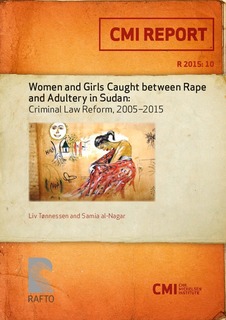| dc.contributor.author | Tønnessen, Liv | |
| dc.contributor.author | al-Nagar, Samia | |
| dc.date.accessioned | 2018-01-04T08:22:48Z | |
| dc.date.issued | 2015-11-01 | |
| dc.identifier | oai:www.cmi.no:5661 | |
| dc.identifier.citation | Bergen: Chr. Michelsen Institute (CMI Report R 2015:10) | |
| dc.identifier.isbn | 82-8062--560-1 | |
| dc.identifier.isbn | 82-8062--560-1 | |
| dc.identifier.issn | 0805-505X | |
| dc.identifier.issn | 0805-505X | |
| dc.identifier.uri | http://hdl.handle.net/11250/2475356 | |
| dc.description.abstract | This report investigates criminal law reform in Sudan, focusing on two important and controversial legal reforms related to (a) a definition of rape that is clearly de-linked from the Islamic crime of zina (i.e., sexual intercourse between individuals who are not married to each other) and (b) a definition of “child” as an individual younger than 18 in statutory rape cases.
Many legal reforms have been proposed in Sudan since the Comprehensive Peace Agreement (CPA) of 2005 officially ended the extended civil war (Africa’s longest) between the north and south of the country. The peace accord opened up some space for women’s groups after a long period of harsh authoritarian control. All Sudanese laws were to be reviewed and reformed in alignment with the Interim National Constitution of 2005, including the Criminal Act of 1991. Although the peace agreement was largely gender-blind, the interim constitution included clauses on gender equality and affirmative action (Itto 2006). Pro-women activists as well as women within the government have been particularly active in advocating for legal reforms since 2005 with reference to the bill of rights. Two major legal reforms – in 2010 and 2015 – have dealt with rape.
The most recent legal reform redefines rape in Sudan’s Criminal Act of 1991. Until February 2015, “rape” was defined as zina (adultery or fornication) without consent. The act of zina was, and still is, punishable by 100 lashes for unmarried offenders and by death by stoning for married offenders. The blending of the ideas of rape and zina in the 1991 act meant that the strict rules of evidence used for zina were also applied to rape, something that constituted a serious legal obstacle for rape victims. Pro-women activists contested this legal position by forming the “Alliance of 149,” named after the rape article in the Criminal Act. Interviews conducted during the last five | |
| dc.language.iso | eng | |
| dc.publisher | Chr. Michelsen Institute | |
| dc.relation | CMI Report | |
| dc.relation | R 2015:10 | |
| dc.relation.ispartof | CMI Report | |
| dc.relation.ispartofseries | CMI Report R 2015:10 | |
| dc.relation.ispartofseries | CMI Report R 2015:10 | |
| dc.relation.uri | https://www.cmi.no/publications/5661-women-and-girls-caught-between-rape-and-adultery | |
| dc.subject | Sudan | |
| dc.title | Women and Girls Caught between Rape and Adultery in Sudan: Criminal Law Reform, 2005–2015 | |
| dc.type | Research report | |
